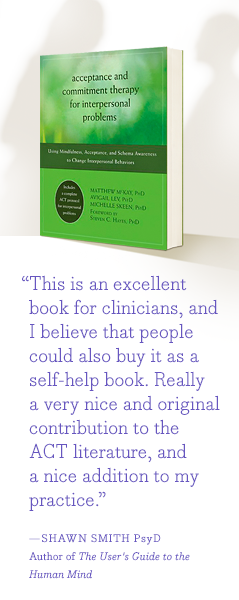Introduction
Clients present with interpersonal problems that often occur across multiple relationships and life domains (friends, work, family, partner, and so on). Pervasive interpersonal problems can thus reach a level that could be seen as an interpersonal disorder, contributing to failed relationships, social isolation, depression, and work dysfunction.
Clients struggling with interpersonal problems are frequent visitors to therapists’ offices. At the Berkeley Cognitive Behavioral Therapy Clinic, for example, more than 50 percent of our intakes identify significant recurring interpersonal difficulties. The majority of clients presenting with depression, trauma, anxiety, and Axis II disorders report interpersonal problems in more than one important relationship. Colleagues across the country report similar data.
Clearly, interpersonal problems are pervasive in the population seeking psychotherapy. Interpersonal problems destroy relationships and trigger extraordinary suffering, both for those affected and for those to whom they relate. Yet for all the pain these problems create, few systems of psychotherapy directly target the interpersonal behavior that drives the problem, and there is little research addressing what treatments effectively change disordered interpersonal functioning (this is discussed in chapter 1). Therefore, the purpose of this book is to offer a treatment that targets relationship-damaging behavior and also has some empirical support (see chapter 1 and appendix B for information on a randomized controlled trial of this therapy in a group setting).
Given that you are reading this book, you probably have clients who struggle interpersonally and repeatedly engage in damaging responses to relational stress. You may also have clients whose primary concern is anxiety, depression, or trauma but who have a history of broken relationships. Among these clients, you may have found that treatment targeting only the emotional problems doesn’t help them reach high levels of well-being. The approach outlined in this book—a schema formulation with mindfulness-and acceptance-based interventions—may provide you new tools to effectively treat these interpersonal problems.
In chapter 1, we briefly discuss current treatments for interpersonal problems, reviewing their effectiveness and shortcomings and explaining why we believe the novel combination of ACT and schema theory is a more advantageous approach. In chapters 2 and 3, we outline how to begin this approach by introducing clients to the concepts of schemas and schema coping behaviors and helping them identify their schemas, triggers, and problematic coping behaviors. Clients also assess how these have impacted their lives and relationships. Chapters 4 through 7 focus on ACT processes: cultivating creative hopelessness, developing mindfulness skills, clarifying values, committing to values-based behavior, cognitive defusion, developing the observer-self perspective, and emotion exposure. The processes and approaches in these chapters are employed to help clients identify how they would rather conduct themselves in relationships and to provide motivation for undertaking the challenging work of changing long-standing patterns of behavior. In chapter 8, we discuss common issues that arise when conducting this therapy and provide suggestions on how to deal with those issues.
The book also contains three appendices. Appendix A is an example of the type of schema questionnaire you might administer before treatment to help identify clients’ key schemas. (We recommend the Young Schema Questionnaire, which you can purchase at schematherapy.com). Note that Appendix B outlines the results of research on the effectiveness of the approach used in this book. Appendix C provides a detailed, session-by-session protocol for conducting ACT for interpersonal problems in a group setting. This group protocol is adapted from the protocol used in the study summarized in appendix B.
You’ll note that there are some differences in the order in which various techniques are presented in the main text versus the group protocol in appendix C. In appendix C the organization is strictly chronological, whereas in the main text, topics are organized more thematically. This thematic organization allows us to present similar techniques and concepts together for clarity’s sake. In practice, you might use techniques from several of the chapters in any given session in response to what’s going on in the room. For this reason, we recommend that you read through the entire book—or at least through chapter 8—before utilizing this approach with clients.
Note that we’ve designed appendix C to be a stand-alone guide to treatment. In theory, you could photocopy this section of the book and use it as your sole reference when conducting group therapy. However, we recommend that you first read chapters 1 through 8 in their entirety so you’ll have a deeper understanding of the approach and the theory behind it. This will allow you to offer group therapy more flexibly, tailoring it to the needs of group members or situations that arise in session.
Feel free to photocopy the handouts and worksheets in this book for use in your practice. However, do note that these materials are protected by copyright, so please seek permission to use them in published material. The exception is the questionnaire in appendix A. It is provided solely as an example. If you wish to use a similar questionnaire in your practice, please visit schematherapy.com, where you can purchase the most current version of Jeffrey Young’s questionnaire for research or clinical use.

